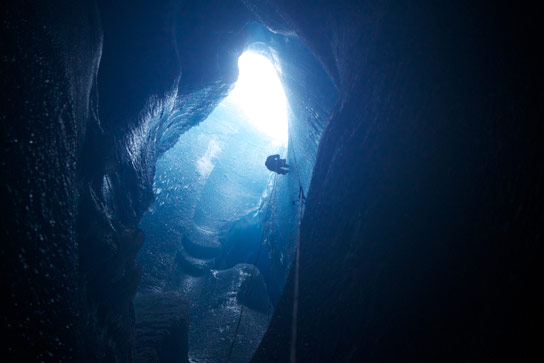
Scientist explores remains of supraglacial lake after it has drained. Credit: Sam Doyle
A new study from the University of Cambridge reveals that the Greenland Ice Sheet, which covers 1.7 million square kilometers (656,000 square miles) and contains enough ice to raise sea levels worldwide by seven meters, is less stable and more sensitive to climate change than previously thought.
A new model developed by researchers at the University of Cambridge has shown that despite its apparent stability, the massive ice sheet covering most of Greenland is more sensitive to climate change than earlier estimates have suggested, which would accelerate the rising sea levels that threaten coastal communities worldwide.
In addition to assessing the impact of the increasing levels of meltwater created and spilled into the ocean each year as the climate continues to warm, the new model also takes into account the role that the soft, spongy ground beneath the ice sheet plays in its changing dynamics. Details are published today (29 September) in the journal Nature Communications.
The Greenland Ice Sheet, which is the second-largest ice sheet in the world, covers 1.7 million square kilometers – an area roughly eight times the size of the United Kingdom – and contains enough ice to raise sea levels by more than seven meters if it were to be lost altogether.
Currently, due to surface melting alone, it is losing ice at a net annual rate of 200 gigatonnes, equating to 0.6 millimeters of sea level rise. A similarly large, but ultimately more uncertain source of sea level rise is tied to a net annual ice loss caused by increased movement of the ice sheet, which results in more ice being discharged into the ocean. Globally, sea levels are rising at three millimeters annually.
Large ice sheets such as in Greenland are far from stationary. Different parts of the ice often move at different speeds, causing ice to shear, a phenomenon known as ice flow.
“When these large ice sheets melt, whether that’s due to seasonal change or a warming climate, they don’t melt like an ice cube,” said Dr. Marion Bougamont of Cambridge’s Scott Polar Research Institute, who led the research. “Instead, there are two sources of net ice loss: melting on the surface and increased flow of the ice itself, and there is a connection between these two mechanisms which we don’t fully understand and isn’t taken into account by standard ice sheet models.”
Whereas other models of the Greenland Ice Sheet typically assume the ice slides over hard and impermeable bedrock – an assumption which is largely practical and based on lack of constraints – this study incorporates new evidence from ground-based surveys, which show soft and porous sediments at the bed of the ice sheet, more like the soft and muddy bottom of a lake than a sheet of solid rock. The new study specifically identifies the intake and temporal storage of water by weak sediment beneath the ice sheet as a crucial process in governing the ice flow.
Using a three-dimensional ice sheet model, together with an observational record of surface melting produced by collaborators at Aberystwyth University, Dr. Bougamont and Dr. Poul Christoffersen were able to accurately reproduce how the ice sheet’s seasonal movement changes in response to the amount of surface meltwater being delivered to the ground below.
Lakes which form on the surfaces of glaciers, known as supraglacial lakes, are often created during the melt season, and typically last from early June to late August. Co-author Professor Alun Hubbard of Aberystwyth University studied these lakes and found that many empty in just a matter of hours, when hydrofracturing opens up water-filled crevasses, resulting in huge amounts of water entering and flooding the subglacial environment. In warmer years, these high-discharge drainage events are expected to become even more frequent.
“Not only is the ice sheet sensitive to a changing climate, but extreme meteorological events, such as heavy rainfall and heat waves, can also have a large effect on the rate of ice loss,” said Dr Christoffersen. “The soft sediment gets weaker as it tries to soak up more water, making it less resistant, so that the ice above moves faster. The Greenland Ice Sheet is not nearly as stable as we think.”
While complete loss of all ice in Greenland is judged to be extremely unlikely during this century, the record extent of surface melting in the past decade clearly shows that the ice sheet is responding to Earth’s changing climate.
In this study, the researchers used two different approaches. First, they used the total amount of surface runoff as a means to drive their model, but the outcome from this experiment was inconsistent with observations. They then used only water stored temporarily in supraglacial lakes on the ice sheet’s surface. They found that although only a small fraction of the total amount of meltwater produced on the surface is stored in supraglacial lakes, the high magnitude and frequency of lake drainage events cause the ice sheet to immediately accelerate as observed.
Having accurately reproduced the hydrological response of ice flow along the western margin of the ice sheet, the authors were able to subsequently evaluate the sensitivity of flow to warmer climatic conditions, resulting in more meltwater on the surface. This showed stable annual flow under present-day conditions, but a more vulnerable ice sheet in warmer years when more meltwater reaches the bed via frequent high-discharge drainage events, not only because of the emptying of supraglacial lakes such as the ones currently observed, but also because daily variations in melt volume will become equally large. The study concludes that there is a limit on how much water can be stored in the soft ground beneath the Greenland Ice Sheet. This makes it sensitive to climate change as well as to the increased frequency of short-lived, but extreme, meteorological events including rainfall and heat waves.
The work was funded by the Natural Environment Research Council (NERC).
Reference: “Sensitive response of the Greenland Ice Sheet to surface melt drainage over a soft bed” by M. Bougamont, P. Christoffersen, A. L, Hubbard, A. A. Fitzpatrick, S. H. Doyle and S. P. Carter, 29 September 2014, Nature Communications.
DOI: 10.1038/ncomms6052









Be the first to comment on "Study Shows Greenland Ice Sheet More Sensitive to Climate Change Than Previously Thought"